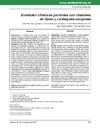Identificador persistente para citar o vincular este elemento:
https://accedacris.ulpgc.es/handle/10553/43724
| Campo DC | Valor | idioma |
|---|---|---|
| dc.contributor.author | Martínez Quintana, Efrén | en_US |
| dc.contributor.author | Rodríguez-González, Fayna | en_US |
| dc.contributor.author | Medina-Gil, J. M. | en_US |
| dc.contributor.author | Ágredo-Muñoz, Julio | en_US |
| dc.contributor.author | Nieto-Lago, Vicente | en_US |
| dc.date.accessioned | 2018-11-21T17:21:07Z | - |
| dc.date.available | 2018-11-21T17:21:07Z | - |
| dc.date.issued | 2010 | en_US |
| dc.identifier.issn | 0009-7411 | en_US |
| dc.identifier.uri | https://accedacris.ulpgc.es/handle/10553/43724 | - |
| dc.description.abstract | Background: Long-term complications of Down syndrome patients with congenital heart disease are poorly known. methods: We carried out a retrospective study of Down syndrome patients with congenital heart disease and patients with atrioventricular septal defect with and without Down syndrome. results: Between 2004 and 2008, 317 patients with congenital heart disease were followed-up in the Adult Congenital Heart Disease Unit. Of these patients, 19 (6%) with a mean age of 26.8 ± 8.1 years had Down syndrome. Atrioventricular septal defect was the most frequent congenital heart disease (63%) followed by ventricular septal defect (26%). Ten patients (53%) were operated on during childhood. Three of these patients required reoperation during adulthood (two patients due to left ventricle outflow tract obstruction and one patient due to left atrioventricular valve insufficiency). Four patients (21%) had Eisenmenger syndrome with improvement of functional class in those treated with bosentan, two patients (10.5%) had bacterial endocarditis and two patients (10.5%) died. No significant differences were seen in left atrioventricular valve insufficiency between atrioventricular septal defect in patients with and without Down syndrome (1.5 ± 0.9 vs. 1.7 ± 0.8, p = 0.689). Conclusions: Left atrioventricular valve insufficiency and left ventricle outflow tract obstruction were the most frequent long-term complications requiring surgical reintervention in patients with atrioventricular septal defect. | en_US |
| dc.description.abstract | introducción: La evolución a largo plazo de pacientes con síndrome de Down y cardiopatía congénita es poco conocida.material y métodos: Estudio retrospectivo de pacientes con síndrome de Down y cardiopatía congénita y pacientes con de-fecto del tabique auriculoventricular y sin trisomía 21.resultados: Entre 2004 y 2008 se hizo seguimiento a 317 pacientes con cardiopatía congénita; 19 pacientes (6%) con edad media de 26.8 ± 8.1 años tenían síndrome de Down. Las cardiopatías congénitas más frecuentes fueron el defecto del tabique auriculoventricular (63%) y la comunicación interven-tricular (26%); 10 (53%) habían sido intervenidos quirúrgica-mente en la infancia, tres de ellos con defecto auriculoven-tricular completo requirieron reintervención en la edad adulta (dos por obstrucción al tracto de salida del ventrículo izquierdo y uno por insuficiencia severa de la válvula auriculoventricular izquierda); cuatro (21%) desarrollaron hipertensión arterial pul-monar, con mejoría del grado funcional al recibir tratamiento con bosentan; dos (10.5%) tuvieron endocarditis bacteriana; dos (10.5%) fallecieron. No existieron diferencias en el grado de insuficiencia de la válvula auriculoventricular izquierda (1.5 ± 0.9 versus 1.7 ± 0.8, p = 0.689) entre pacientes con defecto auriculoventricular con y sin síndrome de Down. Conclusiones: La insuficiencia de la válvula auriculoventricu-lar izquierda y la obstrucción al tracto de salida del ventrículo izquierdo fueron las causas más frecuentes de reintervención en la edad adulta en pacientes con defectos del tabique auri-culoventricular. | en_US |
| dc.language | spa | en_US |
| dc.publisher | 0009-7411 | - |
| dc.relation.ispartof | Cirugía y cirujanos | en_US |
| dc.source | Cirugia y Cirujanos [ISSN 0009-7411], v. 78 (3), p. 245-250 | en_US |
| dc.subject | 320501 Cardiología | en_US |
| dc.subject | 320704 Patología cardiovascular | en_US |
| dc.subject.other | Congenital heart disease | en_US |
| dc.subject.other | Down syndrome | en_US |
| dc.subject.other | Pulmonary hypertension | en_US |
| dc.subject.other | Cardiopatía congénita | en_US |
| dc.subject.other | Síndrome de Down | en_US |
| dc.subject.other | Hipertensión pulmonar | en_US |
| dc.title | Evolución clínica en pacientes con síndrome de Down y cardiopatía congénita | en_US |
| dc.title.alternative | Clinical evolution in patients with Down syndrome and congenital heart disease | en_US |
| dc.type | info:eu-repo/semantics/article | en_US |
| dc.type | Article | en_US |
| dc.identifier.pmid | 20642908 | - |
| dc.identifier.scopus | 78349287019 | - |
| dc.contributor.authorscopusid | 23485891800 | - |
| dc.contributor.authorscopusid | 24825586600 | - |
| dc.contributor.authorscopusid | 36018832900 | - |
| dc.contributor.authorscopusid | 25623267800 | - |
| dc.contributor.authorscopusid | 8642874100 | - |
| dc.description.lastpage | 250 | - |
| dc.description.firstpage | 245 | - |
| dc.relation.volume | 78 | - |
| dc.investigacion | Ciencias de la Salud | en_US |
| dc.type2 | Artículo | en_US |
| dc.identifier.ulpgc | Sí | es |
| dc.description.jcr | 0,133 | |
| dc.description.jcrq | Q4 | |
| dc.description.scie | SCIE | |
| item.fulltext | Con texto completo | - |
| item.grantfulltext | open | - |
| crisitem.author.dept | Departamento de Ciencias Médicas y Quirúrgicas | - |
| crisitem.author.fullName | Martínez Quintana, Efrén | - |
| Colección: | Artículos | |
Citas SCOPUSTM
16
actualizado el 08-jun-2025
Visitas
37
actualizado el 02-mar-2024
Descargas
47
actualizado el 02-mar-2024
Google ScholarTM
Verifica
Comparte
Exporta metadatos
Los elementos en ULPGC accedaCRIS están protegidos por derechos de autor con todos los derechos reservados, a menos que se indique lo contrario.
